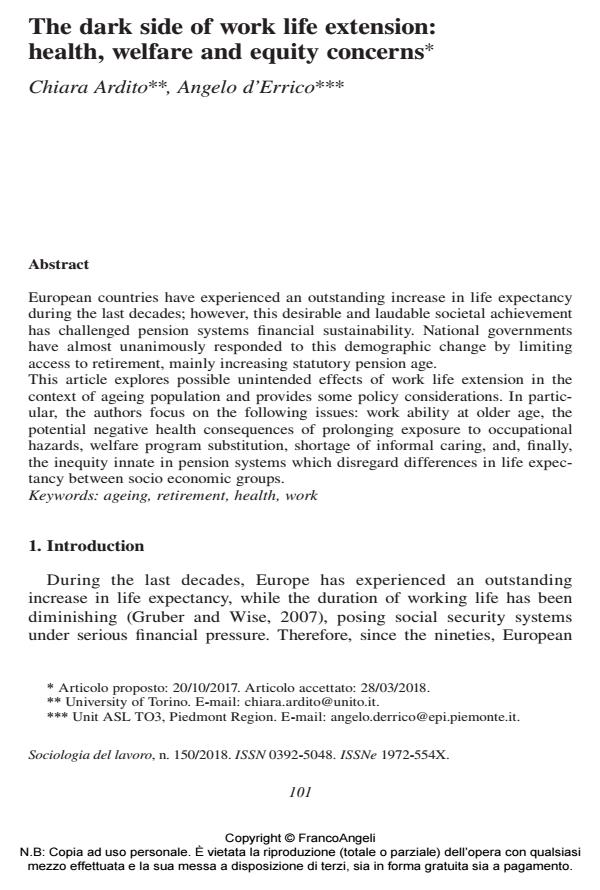The dark side of work life extension: health, welfare and equity concerns
Journal title SOCIOLOGIA DEL LAVORO
Author/s Chiara Ardito, Angelo d’Errico
Publishing Year 2018 Issue 2018/150
Language English Pages 19 P. 101-119 File size 178 KB
DOI 10.3280/SL2018-150006
DOI is like a bar code for intellectual property: to have more infomation
click here
Below, you can see the article first page
If you want to buy this article in PDF format, you can do it, following the instructions to buy download credits

FrancoAngeli is member of Publishers International Linking Association, Inc (PILA), a not-for-profit association which run the CrossRef service enabling links to and from online scholarly content.
European countries have experienced an outstanding increase in life expectancy during the last decades; however, this desirable and laudable societal achievement has challenged pension systems financial sustainability. National governments have almost unanimously responded to this demographic change by limiting access to retirement, mainly increasing statutory pension age. This article explores possible unintended effects of work life extension in the context of ageing population and provides some policy considerations. In particular, the authors focus on the following issues: work ability at older age, the potential negative health consequences of prolonging exposure to occupational hazards, welfare program substitution, shortage of informal caring, and, finally, the inequity innate in pension systems which disregard differences in life expectancy between socio economic groups.
Keywords: Ageing, retirement, health, work
- Early Retirement of Employees in Demanding Jobs: Evidence From a German Pension Reform Johannes Geyer, Svenja Lorenz, Thomas Zwick, Mona Bruns, in SSRN Electronic Journal /2021
DOI: 10.2139/ssrn.3979796 - Early retirement of employees in demanding jobs: Evidence from a German pension reform Thomas Zwick, Mona Bruns, Johannes Geyer, Svenja Lorenz, in The Journal of the Economics of Ageing 100387/2022 pp.100387
DOI: 10.1016/j.jeoa.2022.100387 - Handbook of Bioethical Decisions. Volume I Allen Porter, pp.247 (ISBN:978-3-031-29450-1)
- To Work or Not to Work? The Effect of Higher Pension Age on Cardiovascular Health Chiara Ardito, Roberto Leombruni, David Blane, Angelo d’Errico, in Industrial Relations: A Journal of Economy and Society /2020 pp.399
DOI: 10.1111/irel.12257 - Handbook of Socioeconomic Determinants of Occupational Health Hans Martin Hasselhorn, pp.105 (ISBN:978-3-030-31437-8)
- Older Workers and Labour Market Exclusion Processes Chiara Ardito, Maria Fleischmann, pp.161 (ISBN:978-3-031-11271-3)
- Working Conditions and Health Among Italian Ageing Workers Angelo d’Errico, Chiara Ardito, Roberto Leombruni, Fulvio Ricceri, Giuseppe Costa, Carlotta Sacerdote, Anna Odone, Andrea Amerio, Chiara Ardito, Greta Carioli, Giuseppe Costa, Angelo d’Errico, Dario Fontana, Beatrice Frascella, Giovanni Gaetti, Leandro Gentile, Vincenza Gianfredi, Roberto Leombruni, Anna Odone, Fulvio Ricceri, Carlotta Sacerdote, David Stuckler, Giacomo Pietro Vigezzi, Nicolas Zengarini, in Social Indicators Research /2022 pp.1043
DOI: 10.1007/s11205-021-02862-w - Use of wearable sensors to assess patterns of trunk flexion in young and old workers in the Metalworking Industry Micaela Porta, Pier Francesco Orrù, Massimiliano Pau, in Ergonomics /2021 pp.1543
DOI: 10.1080/00140139.2021.1948107 - Handbook of Socioeconomic Determinants of Occupational Health Hans Martin Hasselhorn, pp.1 (ISBN:978-3-030-05031-3)
- Early Retirement of Employees in Demanding Jobs: Evidence from a German Pension Reform Thomas Zwick, Svenja Lorenz, Johannes Geyer, Mona Bruns, in SSRN Electronic Journal /2021
DOI: 10.2139/ssrn.3985350
Chiara Ardito, Angelo d’Errico, The dark side of work life extension: health, welfare and equity concerns in "SOCIOLOGIA DEL LAVORO " 150/2018, pp 101-119, DOI: 10.3280/SL2018-150006